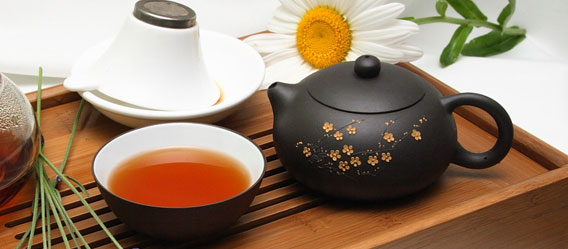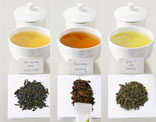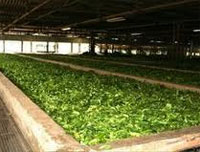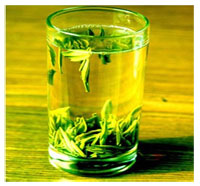|

The cultivation of tea is much like the process of producing fine wine. Each step is carefully planned to achieve optimal results. Elevation of the land and contents of the soil affect the quality of the plant and the time for harvest is chosen according to specific indications. Afterwards, a conscientious selection of leaves takes place along with a step-by-step manufacturing process. While wine is bottled and aged to perfection, however, tea awaits brewing and is valued for freshness.
This carefully planned cultivation process, rather than differences in the plant itself, accounts for the numerous types of tea available. The tea plant, scientifically recognized as Camellia sinensis, yields to few varieties of the same plant found in China, Tibet, India, Burma, and Thailand. Variations in tea leaves are caused by differences in the topography, soil, and climate found in tea growing regions and most especially, the processing methods used during manufacturing. In this newsletter, you will learn the different ways all your favorite teas are made and discover how many of the enticing teas you see in cafes and grocery stores are alike as well as different. (If you would like to learn more about the origination, benefits, or traditions behind tea, please read our July 2003 newsletter, The History and Art of Tea).
Three Primary Teas
 Most of the teas we drink can be broken down into three basic types that all originate from the same plant. These are black, oolong, and green. While black tea undergoes a full oxidation process, called fermentation, oolong tea is partially fermented and green tea circumvents the fermentation process altogether. Given this difference, black, oolong, and green teas are each unique and responsible for a myriad of blended teas in which they are the primary ingredients.
Most of the teas we drink can be broken down into three basic types that all originate from the same plant. These are black, oolong, and green. While black tea undergoes a full oxidation process, called fermentation, oolong tea is partially fermented and green tea circumvents the fermentation process altogether. Given this difference, black, oolong, and green teas are each unique and responsible for a myriad of blended teas in which they are the primary ingredients.
Black Tea Black is the tea of choice in the United States and Europe. Brewed with milk and sugar, it is India’s national beverage. China exports 90 percent of the black tea produced there, and 97 percent of the tea Americans drink is black. Some familiar names in black tea are described below.
Earl Grey: Made with a blend of black tea leaves from India and China. Flavored with oil of bergamot, which is made from Canton orange rind.
English Breakfast: Originally applied to Chinese black tea in the United States. Today it can constitute a blend of predominantly Chinese or Indian black tea leaves.
Assam: The Assam tree is a subvariety of the Camellia sinensis, and grows in Assam, northern India. Assam tea has a strong flavor and is considered one of the world’s finest black teas.
Keemun: A black tea variety that comes from Qimen, China. World-renowned for its optimum flavor and rose-like fragrance. Known as the king of red (black) teas.
Darjeeling: Rivals Chinese Keemun black tea in fineness. Sometimes called “the champagne of teas” for its delicate flavor. Grows in Darjeeling, a mountainous region in India.
Irish Breakfast: A thick, malt-flavored tea made from Assam tea leaves.
Masala Chai: An Indian specialty made from black tea mixed with milk and spiced with cardamom, cinnamon, and pepper.
Processing of each type of tea is preceded by an intricate progression of planting, pruning, and plucking. Four basic steps take place when black tea is processed. It is first withered; then, it is rolled, fermented, and dried. Variations in method or length of time used to carry out these steps yield different results.
 Withering can take 12 to 24 hours, at which time the leaves are spread out on racks. Currents of warm air make the leaves limp enough to be rolled without cracking. The rolling machines break up the membranes of the leaves, which begin to release fragrance and color. During fermentation, the leaves are spread in cool rooms where they absorb oxygen and undergo chemical changes. The reddish color for which black tea is known transforms the appearance of the leaves during fermentation. This color deepens with longer fermentation periods, while the flavor decreases. The fermentation process is brought to a halt in large ovens, or drying machines, where hot air dries the leaves completely, making them appear completely black. Some higher quality leaves repeatedly alternate between fermentation and drying. Black teas are famous for the astringent flavor released during fermentation and for the smooth, glossy, reddish-black color. In China, black tea is known as hongcha, or red tea.
Withering can take 12 to 24 hours, at which time the leaves are spread out on racks. Currents of warm air make the leaves limp enough to be rolled without cracking. The rolling machines break up the membranes of the leaves, which begin to release fragrance and color. During fermentation, the leaves are spread in cool rooms where they absorb oxygen and undergo chemical changes. The reddish color for which black tea is known transforms the appearance of the leaves during fermentation. This color deepens with longer fermentation periods, while the flavor decreases. The fermentation process is brought to a halt in large ovens, or drying machines, where hot air dries the leaves completely, making them appear completely black. Some higher quality leaves repeatedly alternate between fermentation and drying. Black teas are famous for the astringent flavor released during fermentation and for the smooth, glossy, reddish-black color. In China, black tea is known as hongcha, or red tea.
Oolong Tea Processing of oolong tea differs from that of black tea in several ways. The oolong tea leaves are picked at the exact moment of ripening and immediately processed to produce a full-bodied beverage. They are briefly withered in direct sunlight, then rolled by hand to break the cells down only slightly, along the edges. Shaking the leaves in bamboo baskets is one way this is accomplished. The leaves are then air-dried and begin to change color as oxidation occurs, in the areas where breakage is present. The majority of the leaves stay green in color. Shaking and air-drying is alternately repeated, then the fermentation process is interrupted midway by firing. The final color of the leaves is yellowish-green with reddish edges.
Oolong is the most widely served tea in Chinese restaurants within the United States. Because it is slightly fermented, its color should be lively orange-brown to glossy dark-brown in color. Check out the oolong tea selection on Mrs. Lin’s Kitchen, which includes Golden Xuan, considered one of the finest oolong teas, and Red Hood, an oolong tea that comes from the Fujian Province of Wuyi.
Pu-erh (P’u-erh, Pu’er): Pu-erh is a famous tea believed to have medicinal properties that relieve indigestion and diarrhea and reduce cholesterol. It is semi-fermented and grouped with oolong teas, though its fermentation period is longer and its color darker. Its leaves come from a large-leaf variety found in Yunnan China. Flavor is mellow.
Gupu cha (Gook Po cha): A combination of Pu-erh and Chrysanthemum (see description below in Scented and Herbal Teas section) tea.
Ti Kwan Yin (Monkey Picked): This fine oolong comes from high Wuyi country. Because the area is high with conditions difficult for picking, trained monkeys are rumored to pick the leaves. This tea is known to fight high cholesterol and high blood pressure. (Ti Kwan Yin tea is available at Mrs. Lin’s Kitchen. Sealed in an attractive, silver-colored tin canister, it is guaranteed for freshness).
Shui Hsien (Shuixian, Water Sprite): Along with Ti Kuan Yin, this is a leading oolong tea. It is known for a light, orchid flavor and a lasting aftertaste. This tea originated in the Fujian province, and is popularly served in southeastern China.
Liubai (Energizer): This tea is named for its place of origin in Liubai, China. It is fermented longer than oolong tea but less than black tea. The deep reddish-brown color of the tea is said to taste like betelnuts. It is also said to aid in digestion, eliminate fats, and act as a stimulant.
Green Tea Because the leaves are not fermented, green tea does not undergo the chemical changes of black and oolong teas. A combination of rolling and firing turns the greenish-yellow leaves crisp. Prior to this, the leaves may be withered, steamed, or baked for softness. Its fresh and light flavor materializes in a clear, yellowish-green color.
China exports 90 percent of the green tea available on the international market. Nearly 80 percent of the green tea produced in China, however, stays there, as it is the country’s tea of choice. The most widely known green teas from China are Lung Ching, Huangshan mao feng, pi lo chun, puto fa cha, and lu’an guapian.
Japanese green tea comes in three basic categories: sencha, bancha, and tencha. Bancha is a lower-quality tea made with fresh stems, branches, and few leaves. Sencha is a very popular green tea, clear and clean in color, and made from a leafier blend. Tencha (or macha) is the ceremonial powdered tea.
Green tea is widely recognized for health benefits, particularly fighting cancer. A wide range of green teas is available at Mrs. Lin’s Kitchen. Some popular names in green tea are described below.
Gen mai cha (brown rice tea): Made from green tea and toasted brown rice. A staple beverage for children in Japan, similar to hot cocoa in the U.S.
Hyson or Young Hyson: Once a widely used name for Chinese green tea, it is occasionally used today. Young Hyson refers to Chinese green tea using tender young leaves, though many teas use this grade of leaf.
Gunpowder tea: Tightly rolled balls of green tea that resemble gunpowder. Named Zhucha (Pearl) in Chinese. Special skill is required to give this tightly rolled variety its special shape, which enables the tea to stay fresh longer. Has a strong flavor with a lasting aftertaste. (Gunpowder tea is available in the Grocery Section at Mrs. Lin’s Kitchen, sealed in jars made from authentic Yixing clay).
Eyebrow tea: Several famous green teas, such as Chunmee, Showmee, Sowmee, and Xiumei, are called eyebrow teas because of their distinctive shape. The shape is achieved with great precision during firing. Taste of the tea is mellow.
Lu’an Guapian (Lu’an Melon Seeds): One of the five best-known green teas in China. Processed leaves are sweet-tasting and shaped like melon seeds.
Silver Needles: This white tea variety of camellia sinensis is often grouped with green tea. While it resembles green tea in appearance, it is the least processed of the teas and is considered one of the most glamorous teas in the world. Made from the yellow-white buds covered with silvery-white hairs and plucked just after opening. Silver Needles is a popular name for white teas. (A Silver Needles White Tea selection is available at Mrs. Lin’s Kitchen. Its freshness is guaranteed in an attractive, silver-colored tin canister).
Tea Grades After tea is processed, it is sorted to a uniform size for each grade of tea. We have already observed, with eyebrow and gunpowder teas, how the shape and size of a tea leaf accounts for a great deal in its final identity. Even when their aesthetic value is not so highly prized, the different grades of tea are significant. The primary categories of tea grades are described below.
Leaf grade: Loose tea contains whole leaves, which can be bought by quantity. Not available in tea bags. Tea connoisseurs prefer this grade, where the quality of tea can be measured and controlled.
Broken grade: The tea sold in bags is usually of broken grade quality, where the leaves have been crushed in small pieces. Produces a dark, strong brew more quickly.
Dust: The finest siftings of tea. Also used in tea bags.
Fannings: Made from small, flat pieces of tea, sometimes with buds.
Pekoe: A familiar word for the average tea drinker. Pekoe does not refer to the quality or variety of the tea but to the size of the leaves. These are two-leaf-one-bud sets that are sifted to a particular size. Orange pekoe is slightly larger, and once referred to orange-scented tea. Today, it only refers to the size of tea. Flowery orange pekoe includes the tips, or buds of the leaves.
Scented and Herbal Teas
 Some teas have the names of flowers or fruits. The flower or fruit is not the source of the tea, rather it used to scent a particular blend of black, oolong, or green tea. Jasmine, peach, or red currant are examples of such blends. Chrysanthemum tea is an exception to this rule, as it is made solely from dried chrysanthemum blossoms that are infused like tea. A popular Chinese fruit used to enhance tea is lichee. The juice from this white-colored fruit is often used to treat black tea in order to enhance it with a tarty taste. Other popular black teas from China are made with rose petals. Herbal teas are simply made from dried herbs that brew nicely in boiling water. Such teas do not come from the tea plant, and are referred to as tisanes. Verbena, chamomile, or mint are popular varieties of herbal tea. Begin your exploration of scented teas today with a jasmine, peach, or lichee selection available at Mrs. Lin’s Kitchen. Some teas have the names of flowers or fruits. The flower or fruit is not the source of the tea, rather it used to scent a particular blend of black, oolong, or green tea. Jasmine, peach, or red currant are examples of such blends. Chrysanthemum tea is an exception to this rule, as it is made solely from dried chrysanthemum blossoms that are infused like tea. A popular Chinese fruit used to enhance tea is lichee. The juice from this white-colored fruit is often used to treat black tea in order to enhance it with a tarty taste. Other popular black teas from China are made with rose petals. Herbal teas are simply made from dried herbs that brew nicely in boiling water. Such teas do not come from the tea plant, and are referred to as tisanes. Verbena, chamomile, or mint are popular varieties of herbal tea. Begin your exploration of scented teas today with a jasmine, peach, or lichee selection available at Mrs. Lin’s Kitchen.
Tea Selection Learning how to distinguish fine tea takes practice. General guidelines involve clean, taut appearance of leaves, glossy rather than dull or muddy color once brewed, aromas that coincide with the strength and variety of the particular tea, and a smooth, fresh taste that is not imbalanced or excessive. Because there are so many varieties of tea available, there may be various exceptions to these rules, depending on the type of tea in question. In the end, your cup of tea should simply be a soothing, pleasing tea with just the right flavor. Enjoy!
|
|
 |
OUR 2003 NEWSLETTERS
Discover Your Cup of Tea
The Mythical of Dragon and Phoenix
Korean Celadon
The Art of Japanese Cuisine
Chinese Horoscope
The History and Art of Tea
A Taste of The Philippines
The Dimsum Experience, Part II
The Dimsum Experience, Part I
The Art of Paper Cutting
Feng Shui for the Home
New Year's in Asia
NEWSLETTER ARCHIVES
2011
2010
2009
2008
2007
2006
2005
2004
2003
2002
2001
MAY WE SUGGEST:
Hojicha or Roasted Green Tea
(7078)
Sencha-and-Matcha Blend (7082)
Premium Japanese Sencha Tea (t1414)
Ice Green Tea (7076)
Discovering, Exploring, Enjoying Tea Manual (11235)
|